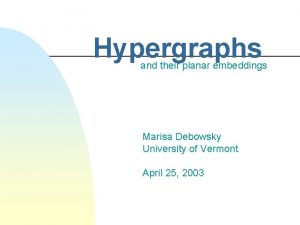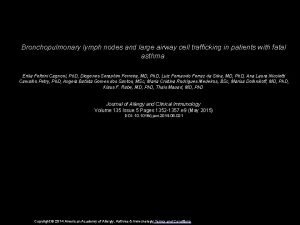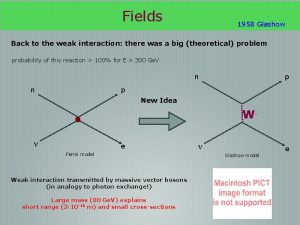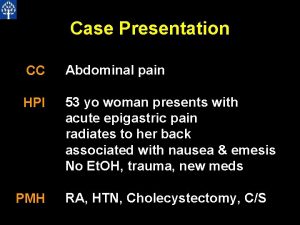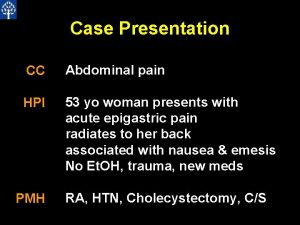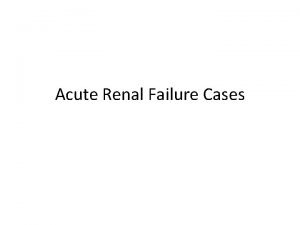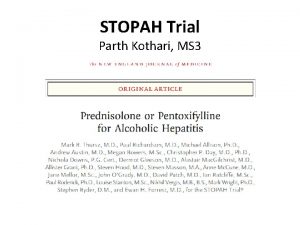Case Presentation Marisa Glashow MS IV HPI 21


















- Slides: 18

Case Presentation Marisa Glashow, MS IV

HPI • 21 y/o Female with PMHx ovarian cysts and hypercholesterolemia • Substernal Chest Pain x 10 days • Pain worsened 3 days ago • Radiates to left scapula and epigastrum • Sharp, 10/10, constant pain • Worse with movement, breathing, and laying supine • SOB associated with pain • Dry Cough x 1 week

HPI • Two days prior to onset of symptoms patient strained back • One week prior to onset of symptoms patient took two 6 hour car rides • Intentional 25 lb weight loss over past 18 months • Mild reflux • LMP 1 week prior to visit • Denies: • Fever/chills • Calf Pain • Nausea/Vomiting

Allergies • NKDA Medications • Lovaza • OCP PMHx • Ovarian Cysts, Hypercholesterolemia PSHx • Tonsillectomy Social Hx • + Tobacco 1 ppd x 4 years

Vital Signs • • • Temp 97. 7 F HR 111 RR 22 BP 130/66 Sp 02 99%, room air

Physical Exam General • No Acute Distress Respiratory • Rapid, shallow breaths • CTA bilaterally • No wheezes/rales/rhonchi Cardiac • +S 1/S 2 • Regular rate and rhythm • No murmurs/rubs/gallops

Physical Exam Abdomen • • Soft + Bowel Sounds Nondistended Tender to palpation slightly distal to xiphoid process that extends to right and left anterior axillary lines • Negative Murphy’s Sign Extremities • No calf tenderness • No edema of lower extremities Back • Reproducible tenderness over left scapula • Limited ROM of left shoulder

Labs 14. 0 12. 0 Total Bili 0. 6 Alk Phos 95 AST 16 ALT 11 222 40. 7 142 104 BHc. G (-) U/A (-) 12 88 4. 5 27. 5 0. 9

Differential Diagnosis • • • Pericarditis Pneumothorax PE Gastritis Costochondritis Musculoskeletal Pneumonia Cholecystisitis Splenic Rupture

ED Course • EKG & Troponins • EKG: Normal Sinus Rhythm • Troponin: 0. 00 • CK: 42 • CXR • No significant findings • Maalox & Zantac • No improvement • • Toradol 30 mg IV • No improvement D-dimer • 0. 65 • CT Chest with PE Protocol • Bibasilar consolidation • Discharged with Azithromycin

Atypical Pneumonia • Most common organism is Mycoplasma pneumoniae • Symptoms: • • Chest Pain Headache Sore Throat Dry Cough Low-Grade Fever Fatigue Myalgias • Signs: • • Pulse-Temperature Dissociation No Signs of Consolidation • Diagnostic Studies: • PA & Lateral CXR-diffuse reticulonodular infiltrates with absent or minimal consolidation • First-Line Treatment: • Macrolides or Doxycycline

CXR vs. CT • Retrospective study determining the incidence of PNA diagnosis in the ED using thoracic CT after obtaining a negative or nondiagnostic CXR • Analyzed charts of 1057 patients diagnosed with PNA • 97 patients had both CXR and CT performed • 26 (27%) of patients had negative or non-diagnostic CXR, but CT showed infiltrate or consolidation consistent with PNA • CT has a higher sensitivity than CXR for diagnosing PNA • Concluded that future studies need to analyze radiographic diagnostic techniques used for PNA

CXR vs. CT • False Negative CXR more common: • • • dehydrated patient immunocompromised patient portable CXR done at bedside • Drawbacks to CT: • • • cost limited availability increased radiation exposure • Consider CT: • • empyema or effusion suspected immunocompromised patient underlying malignancy suspected diagnosis is unclear

CXR vs. Ultrasound • Determine whethere is a difference in sensitivity, specificity, and likelihood ratios in the diagnosis of PNA with lung ultrasound vs. CXR • Subjects were 120 patients admitted to the hospital with communityacquired pneumonia • Ultrasound Exam: • Performed by one ED physician who was non-blinded to the subject’s clinical condition • Longitudinal and oblique views of the inferior and superior portions of the anterior and lateral chest • Two mid-posterior views • PA & Lateral CXR read by radiologist who was blinded to the subject’s clinical condition

CXR vs. Ultrasound

CXR vs. Ultrasound

Things to Remember… • Don’t forget to consider atypical pneumonia • When ruling out pneumonia, don’t forget that CXR can be falsely negative • Dehydrated patients • Immunocompromised patients • Ultrasound has a higher sensitivity than CXR for diagnosing pneumonia • CT continues to be the gold standard for diagnosing pneumonia

Bibliography Agabegi, Steven. Step-Up to Medicine. 2. Philadelphia: Lippincott Williams & Wilkins, 2008. Cortellaro, F. "Lung ultrasound is an accurate diagnostic tool of pneumonia in the emergency department. " Emergency Medicine Journal. 29. (2012): 19 -23. Goljan, Edward. Rapid Review: Pathology. 3. Philadelphia: Mosby Elsevier, 2010. Hayden, G. "Chest radiograph vs. computed tomography scan in the evaluation of pneumonia. " Journal of Emergency Medicine. 36. 3 (2009): 266 -270. Marrie, TJ. "A controlled trial of a critical pathway for treatment of community-acquired pneumonia. CAPITAL Study Investigators. Community-Acquired Pneumonia Intervention Trial Assessing Levofloxacin. . " JAMA. 283. 6 (2000): 749 -755.
 Glashow md
Glashow md Glashow resonance
Glashow resonance Best case worst case average case
Best case worst case average case Marisa ponti
Marisa ponti After the wedding poem
After the wedding poem Marisa pascual
Marisa pascual Open stax
Open stax Teoria di leininger
Teoria di leininger Carrie bourassa
Carrie bourassa Greek mythology 101
Greek mythology 101 Bolo de banana ana maria braga
Bolo de banana ana maria braga Marisa flores fotografa
Marisa flores fotografa Marisa betancourt
Marisa betancourt Marisa debowsky
Marisa debowsky Marisa orbea
Marisa orbea Marisa dolhnikoff
Marisa dolhnikoff Sejarah hukum perdata internasional
Sejarah hukum perdata internasional Renvoi dalam hpi
Renvoi dalam hpi Ruang lingkup hpi
Ruang lingkup hpi













